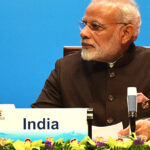
Myanmar is important to India in terms of internal security as well as external factors
India’s neighbourhood policy is being tested like never before, thanks to an ongoing border stand-off with China, a faltering relationship with Nepal over an unusual assertion of sovereignty by the Oli government, and perpetual high tensions with Pakistan. The February 1 coup in Myanmar has only compounded matters.
Initially, India’s Ministry of External Affairs reacted cautiously to the coup in Myanmar, expressing “deep concern” but also noting past support for democratic transition. The careful reaction by New Delhi illustrates the guarded nature of its approach to developments in Naypyidaw. India was not always so supportive of Myanmar’s generals. After the 1962 coup, India-Myanmar ties, like that of many nations, were severely restricted. When Myanmar began its democracy movement in 1988 and acts of violence by the military were widespread, India was among the first to be critical, even aiding pro-democracy activists through the Indian Embassy. In 1993, India honored Aung San Suu Kyi with the Jawaharlal Nehru Award for International Understanding. The Modi government’s fence-riding approach to the current coup d’état is also indicative of how India’s interests have matured over the years and how those interests have crisscrossed with those of China in Southeast Asia. There is a deliberate nuance in India’s approach to the Tatmadaw — that of seeking seeks to avoid interference in the internal affairs of other states while balancing that with its security compulsions.

The situation in Myanmar is complex for India as it is caught between the pressure to join the chorus of nations calling for a return to democracy and the indispensability of Myanmar in helping India contain its insurgency in the northeast. The other issue is of China, and its increasing stakes inside Myanmar, particularly its stakes with anti-India insurgents. Furthermore, the complexity of Myanmar’s capability to help India in the northeast is further compounded by the Tatmadaw’s own complex relations with China. This geopolitical intricacy overrides India’s stand on the current crisis.
Although it may put India in league with China in keeping out of a chorus for the return of democracy, it is underscored by India’s own security necessities in the North-East. For example, Myanmar helped India conduct joint operations inside its sovereign territory to contain insurgency in the northeast and in June 2015, India announced that it had conducted a cross-border operation against insurgents belonging to the National Socialist Council of Nagaland-Khaplang (NSCN-K). Most recently in January, NSCN-K leader Niki Sumi was forced to abandon its base in Myanmar after an offensive by the Tatmadaw. This came only after a visit by Indian Army chief General M M Naravane to Myanmar. The rooting out of Sumi was seen as a victory for India and the result of strengthened ties in Myanmar and in the wider Indo-Pacific.
Myanmar has also become another front in the geopolitical competition between India and China. While China has developed a number of infrastructure projects in the country, concerns have been raised about Beijing’s growing economic clout. China eventually agreed to a lower 70 percent stake in the strategically important Kyaukpyu seaport, a critical component in its Belt and Road Initiative linking regional economies with mainland China. Beijing is also a supplier of arms and other equipment to insurgent groups in the country, of which carry out activities inside India. Recent visits by Chinese leaders to Myanmar, such as that of Premier Xi Jinping in January 2020 have demonstrated a renewed focus on Myanmar. China is all over the geographical map in Myanmar — from oil and gas pipelines, as well as railways that would link the interior with the Chinese mainland. As such, Chinese interests inside Myanmar have also aimed to sabotage India’s presence, which makes the current political crisis of grave concern to both New Delhi and Beijing.
India’s current stand creates a broader spectrum of relationships with Myanmar which is unique insofar as it has demonstrated its capacity to work with both a military regime and a democratically-elected leader. India in the future is likely to cautiously nudge the Tatmadaw into returning democratic rule, but continue to work with General Min Aung Hlaing, to which it has a working relationship. In 2019, India and Myanmar signed a memorándum of understanding to elevate cooperation in the defense sector, evidenced in $100 million in military sales. India is now the top defence supplier to Myanmar, compared to China which has sold about $47 million.
Since the construction of the Kyaukpyu seaport, China’s ability to circumvent its Malacca dilemma has underscored the immediacy of a geostrategic upper hand in the Bay of Bengal–and increased the importance of Myanmar in India’s foreign policy. Myanmar is important to India in terms of internal security, as well as external factors such as the strategic competition with China. Therefore, India has prioritised its own security interests over the temptation to push for democracy, reflective of a new sense of realpolitik in Indian foreign policy.
This article was co-authored with Dr. Vivek Mishra, Deputy Director, Kalinga Institute of Indo-Pacific Studies.






